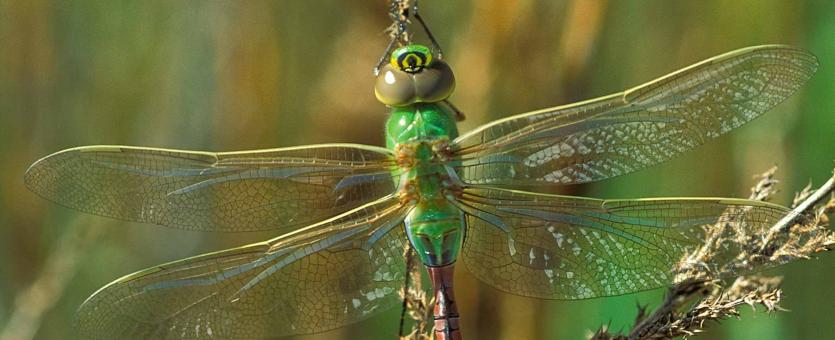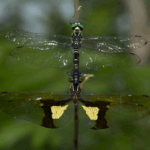Green darners are the biggest darner in North America and also the most widespread. They have a green thorax and a blue (male) or brownish (female) abdomen. Like most darners, they’re aerial for most of the daylight hours, continually patrolling for food and mates. They can hover and even back up a bit, but they are most comfortable in fast forward flight, usually at least three feet high over land or water, often higher. They can eat any insect smaller than themselves, including smaller dragonflies. They grab their prey in flight with a basket-shaped array of legs and usually eat it while flying. The only times they stop flying are for sleep (when they grasp a stem and hang down) or for parts of mating and egg-laying. They’re like the Swifts of the insect world.
Male green darners are aggressively territorial, patrolling a patch of pond and physically ramming any intruders. If a receptive female should enter the territory, the male performs a looping aerial display. If she doesn’t leave, he’ll seize her behind the head with his abdomen while flying. She will then reach forward under him with her abdomen to receive sperm from a sac just behind his thorax. This leads to a bizarre-looking circle position called the ‘wheel’; the pair often alight on vegetation while in the wheel (so there are quite a few pictures of darners in this position). After 10-20 minutes, the female will uncurl her abdomen, while the male drags her aloft. They will search, as an attached pair, for grass and herb stalks sticking out of a puddle or shallow pool. Alighting on the stalk, the male will back the female down the stem so that she can use her abdomen and ovipositor to insert an egg into the stem below the waterline.
Creature Feature: Green Darner Dragonflies
green and blue slivers
the dragonflies whirl and dart
high and low circles
The above haiku is one of many about dragonflies, an insect contemplated in Asian poetry and prose for hundreds of years. But you don’t need to be haiku master Basho to appreciate these fantastic little predators. We in Ohio are blessed with over a hundred species, each with a cool and unique place in the ecosystem. We’ll illustrate this by focusing on a common large species, the Green Darner (Anax junius).
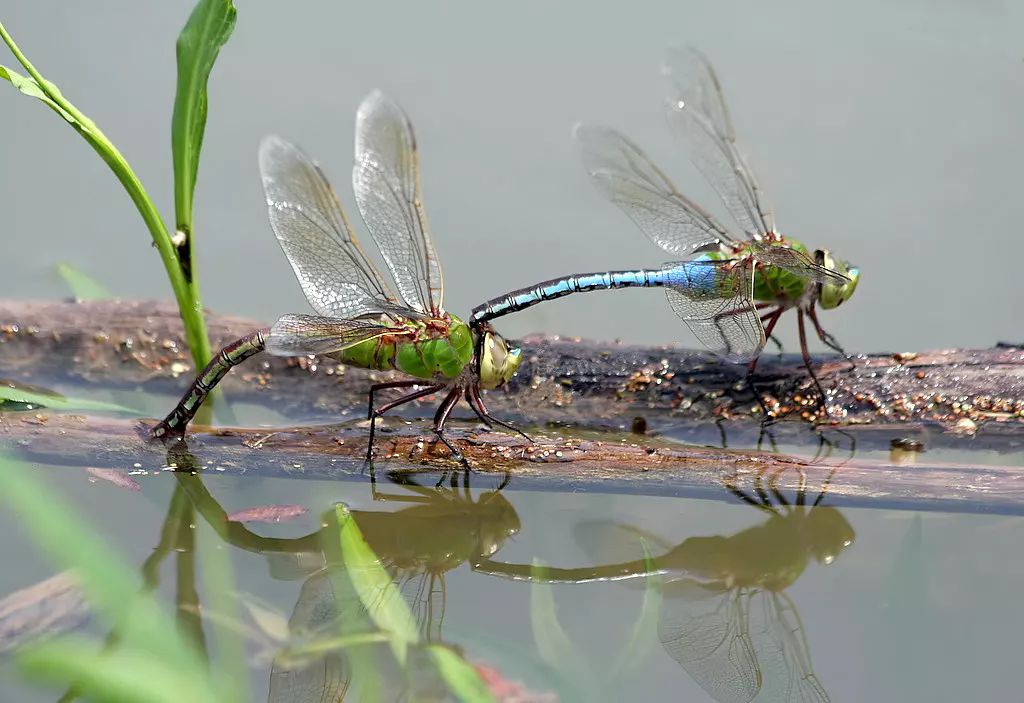
Green darners are most people’s idea of a dragonfly. They are part of the darner family (Aeschnidae), a widespread family of big dragonflies. Big (up to five inches long), brightly colored, and exceedingly fast, darners are among the master aerialists of the insect world. They have to be to survive in a world of hungry birds who are mostly much larger than themselves. Incredibly, they’ve done so by updating a very primitive flight system that started evolving before there were dinosaurs or birds. Their long wings cannot be folded up or tucked in, so for adult dragonflies, it’s fly or die.
The egg is protected in the stem until hatching, whereupon the tiny nymph crawls out into the water. They are very different from the aerial adults, being shorter, brown/green-camouflaged, and gilled for survival in the water. They’re ambush hunters, grabbing small worms, insects, tadpoles, and even tiny fish. They have an extensible, hooked lower ‘lip’ that they use to strike at potential prey with lightning speed.
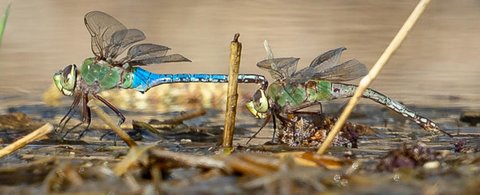
As it grows, the dragonfly nymph starts to take on more adult characteristics, such as long abdomen and wing buds. After it reaches a large size, some combination of size and environment trigger the nymph to crawl up out of the water and eclose, in which it bursts through its old skin and re-forms itself as an adult dragonfly. The process is elegantly summarized in another video.
Green darners have another secret: some of them migrate. Large flocks have been seen along mountain ridges and shorelines in both autumn and spring. Like monarch butterflies, this migration is a multi-generational affair; the dragonflies that journey south will not be the ones that come back north next spring. Unlike monarchs, though, green darners don’t seem to gravitate to a specific area. We know little about the mechanisms or specifics about darner migration, so this is an area where some wow facts will likely come out over the next few years.
What about darners in central Ohio? They return here in April or May, depending on how warm weather is during the spring. They’ve been here since early April this year. They forage over almost any lake or pond or marsh, so large wetlands are usually a good place to search for them. Pickerington Ponds and the Darby Creek wetlands are good places for them, as are some of the park ponds like Thoreau Lake at Blendon or Darby Bend Lakes at Prairie Oaks. Just look for the blue-green blurs circling high over the water. Come September, they’ll make their exit, so enjoy them now.
Habitat
Ponds, lakes, and slow streams with vegetation.
Dragonflies needs water to reproduce. In summer, the common green darner buzzes around warm, still water, such as lakes, ponds, wetlands, marshes, and backwater areas of slow streams throughout North America. Nonbreeding common green darners may forage anywhere they can find prey, including dry areas and outside of North America.
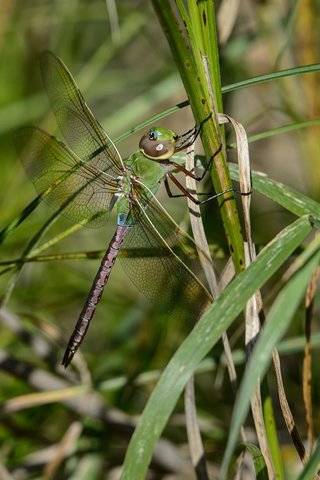
Life Cycle
Juveniles in Canada and the northern Unites States flock together in the fall and migrate south, following the north shore of Lake Superior for part of their route. Radio tagging has shown that they fly as much as 87 miles in a day. American Kestrels (Falco sparverius) migrate at the same time using the same route, and may use the darner migration as a food source during their migration. There is also a resident population that overwinters as larvae. The migrant population reproduces in the southern United States and their offspring migrate north in the spring.
Eggs are deposited inside the stem of emergent vegetation below the waterline. This is the only darner that lays eggs while the male and female are still in tandem. The naiads take several years to mature. When they mature they crawl up an emergent plant and an adult emerges at night.
The common green darner dragonfly (Anax junius) is about three inches long and has a bright green thorax. Males and females can be distinguished by the color of their abdomens — males’ abdomens are an intense blue while females’ abdomens are reddish brown. Green darner naiads (or immatures) live in ponds and streams and have cylindrical bodies with long legs.
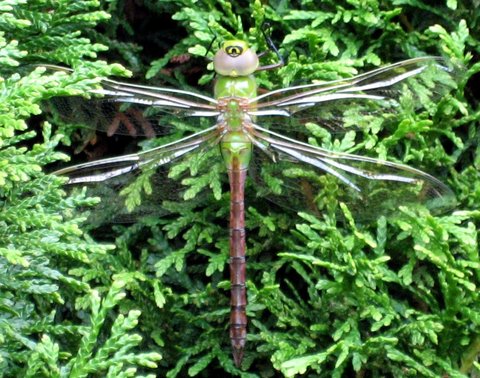
What does it eat?
Like other dragonflies, the green darner is a skilled aerial predator. They eat many types of flying insects, such as flies, gnats, moths, butterflies, mayflies, damselflies, mosquitoes, and even other smaller dragonflies. The aquatic naiads eat other small aquatic insects, and can even eat small fish and tadpoles.
Where and when do you find them?
The common green darner dragonfly is one of the most abundant dragonflies in North America. They are one of the first dragonflies to be seen in the spring, and can still be spotted through late fall, oftentimes near ponds and marshes.
Importance to Minnesotans
Like the monarch butterfly (the state insect of Minnesota), the common green darner dragonfly also migrates across the continent each year. These dragonflies leave Minnesota in July through October to head south. Once there, they lay eggs and die, but the new generation begins to make its way back up north in the spring. However, unlike monarchs, some green darners don’t migrate at all, and live their entire lives in Minnesota. These dragonflies overwinter as naiads in frozen over ponds and emerge as adults the next spring once the weather warms up again.
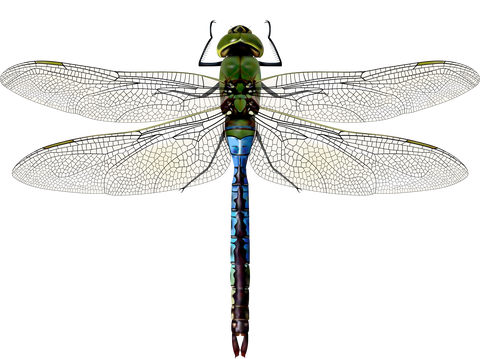
green darner dragonfly facts
The name Anax junius most directly translates to Lord of June, as Anax is a Greek word meaning lord, king, or master. Darner dragonflies (family: Aeshnidae) are also nicknamed “devil’s darning needles,” “mosquito hawks,” or “horse stingers,” although they don’t possess any stingers.
Distribution
The Common Green Darner lives throughout North America and south to Panama.On the Refuge, look for this species anywhere during the summer, but especiallyalong the ditch bordering the gravel road that parallels Road 99W. Even withoutbinoculars you can usually pick out this species by its distinctive color pattern as itworks up and down the ditch.
This darner is one of a handful of dragonfly species that migrate in the fall, thoughnot all individuals migrate. The migrants gather in large numbers along the coast in the fall. When conditions are right, theyhead south. Little is understood about this migration. The Xerces Society and other organizations formed the MigratoryDragonfly Partnership to encourage citizen participation in studying darner migration.
- The Common Green Darner is Washington’s state insect.
- Darners were apparently named after the darning-needle. Old popular names included “devil’s darning needle” and“eye pokers”.
- Fossils of primitive dragonflies are as much as 325 million years old. Thus, they predate the dinosaurs. One hugedragonfly species had a wing span of 30 inches!
- Eyes take up much of the head of a dragonfly and allow it to see in almost every angle except behind. These arecompound eyes, which have roughly 30,000 facets and are especially sensitive to motion.
- Do dragonflies bite people? Yes, if you catch one and hold it, it will defend itself by biting if its mandibles can reachyour skin. The bite is usually not strong enough to break the skin.

